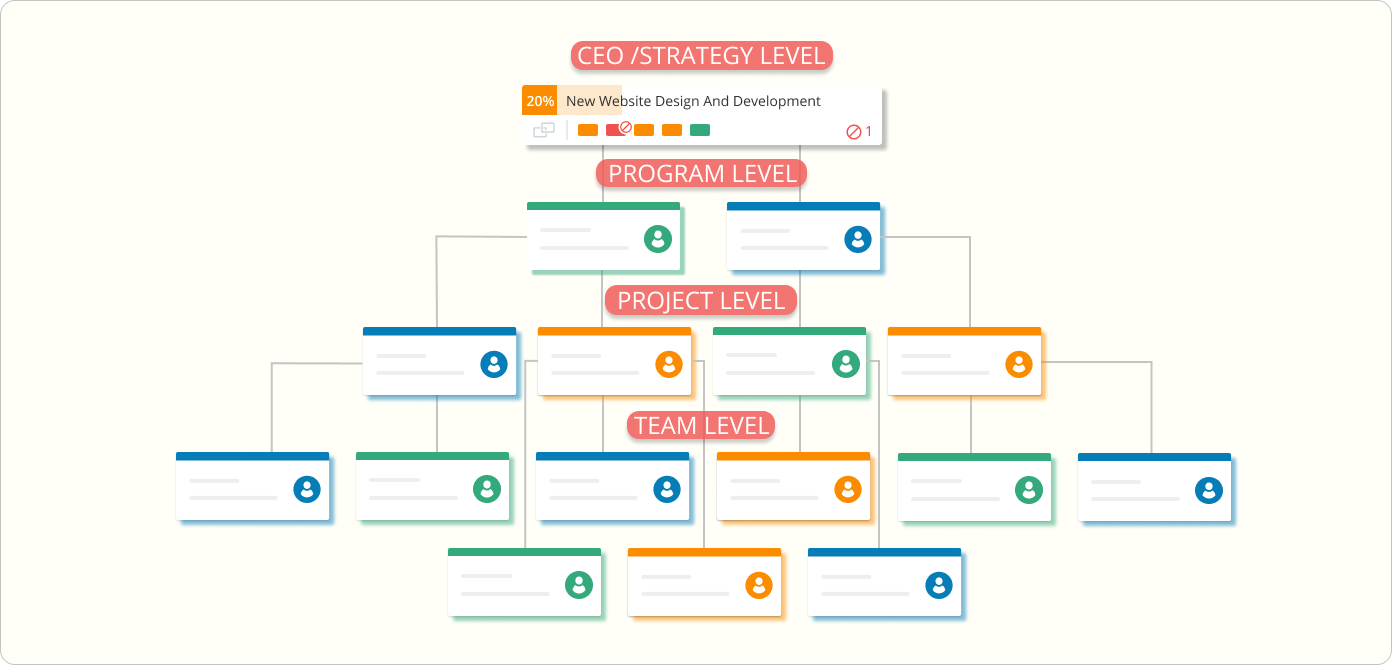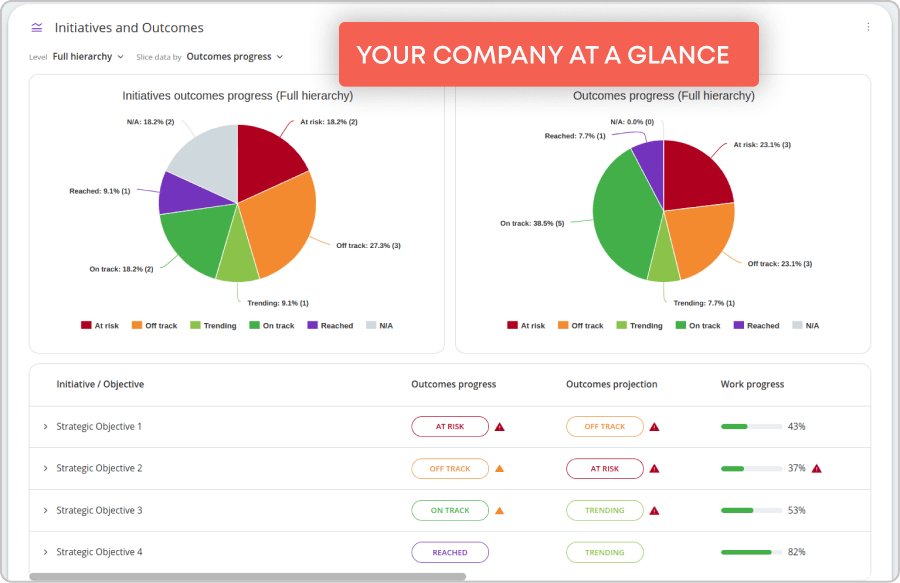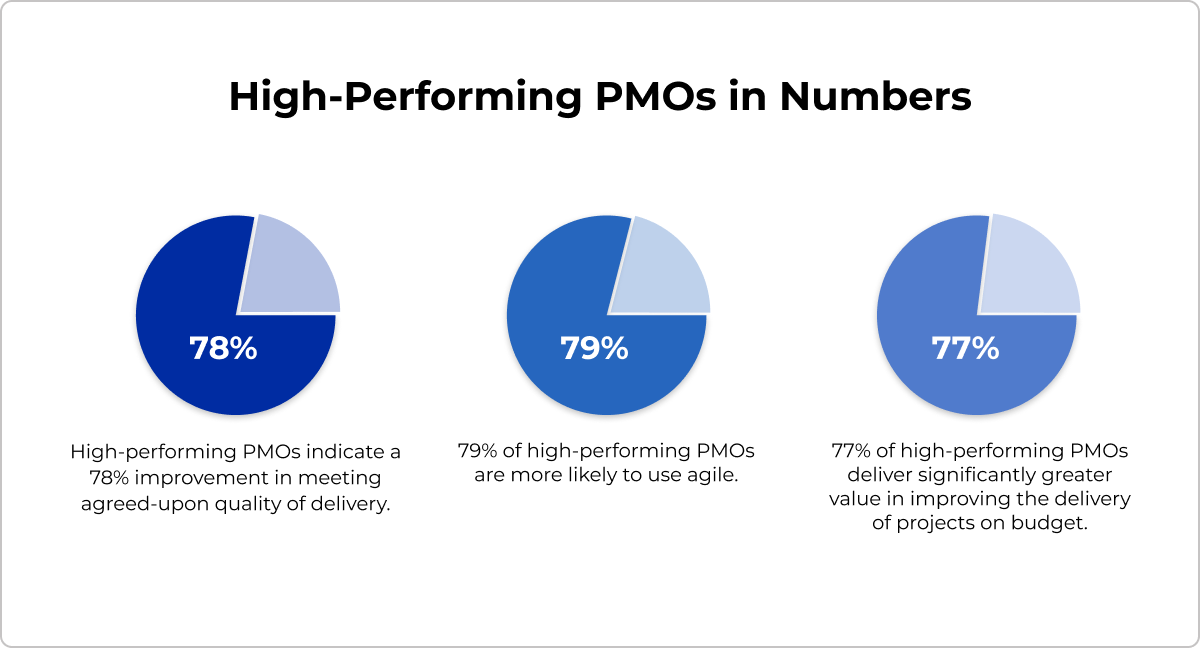How did the value of PMOs go from being doubted in the past to now being unquestioned in 67% of organizations? Clearly, the role of project management offices has changed significantly over time.
To tackle this question, we have gathered all the fundamentals you need to understand what a PMO is and its importance to successful strategy execution. You’ll also find insightful data about the current state of PMO.
What Is Project Management Office (PMO)?
A PMO is a centralized team, department, or functional unit within an organization dedicated to standardizing and improving project management practices. The PMO facilitates better communication, more accurate reporting, and strategic project management decisions by standardizing processes. It's the backbone that aligns project goals with the company's strategic objectives, ensuring that projects are executed efficiently and consistently.
Key PMO Roles and Functions
The PMO concept plays a vital role in ensuring project success. Some of the key functions and attributes of PMOs that support project work include:
-
Governance: Establishing processes and policies for managing projects.
-
Project Support: Offering support, guidance, and resources to project managers.
-
Resource Management: Allocating resources efficiently to maximize project success.
-
Performance Monitoring: Tracking and analyzing project performance to ensure continuous improvement.
What Are the PMO Types?
When it comes to PMOs, one size does not fit all. The type of PMO you need depends on your organization's size, complexity, and strategic goals.
Supportive, Controlling, and Directive PMOs
These three types describe the level of control and engagement a PMO has over projects within the organization:
1. Supportive PMO: This type offers support and guidance to project managers through guidance, best practices, and access to information.
2. Controlling PMO: A step up from the supportive type, this PMO oversees compliance and ensures that project management standards are being followed. It checks and balances projects but only manages them indirectly.
3. Directive PMO: The most hands-on type, the Directive PMO actively manages projects and allocates resources, ensuring consistency and alignment with organizational goals. It's responsible for the direct management and execution of projects.
Enterprise, Divisional, and Project PMOs
The following PMO types describe the scope and placement of the PMO within the organization.
1. Enterprise PMO (EPMO): Focuses on aligning project, program, and portfolio activities with the strategic goals of the entire organization. It operates at a high level, often with a company-wide scope. The EPMO structure is suitable for organizations with well-established project management capabilities helping to accomplish strategic business objectives.

2. Divisional PMO: Operates within a specific division or department, aligning projects with the division’s specific objectives and strategies.
3. Project PMO: Established for a specific project or set of projects, often disbanded after completion.
The Supportive, Controlling, and Directive types describe how the PMO functions in terms of control and influence over projects, while the Enterprise, Divisional, and Project types describe where the PMO sits within the organization and the scope of its responsibilities. These types are not mutually exclusive; they can overlap depending on the organization's structure, culture, and needs.
For example, an EPMO can be directive, or a Divisional PMO can operate in a supportive capacity. The key is understanding the organization's unique needs and tailoring the PMO structure accordingly for optimal effectiveness.
PMO Importance for Successful Project Delivery
According to The Standard for Project Management, projects are considered a “part of a system for value delivery within organizations.” PMOs are also part of the same system with the following key functions and capabilities critical for successful project delivery:
Keep Projects Aligned with the Strategic Direction
One of the primary capabilities of a PMO is to ensure that all projects undertaken align with the organization's strategic objectives. This involves understanding the business strategy, translating it into actionable project goals, and continuously aligning project outcomes with these objectives. Unsurprisingly, the PMOs' most significant impact on organizations for the last 2 years was aligning projects with business objectives, showing a 64% improvement.
For instance, PMOs can use platforms to keep track of all the details about how projects and goals are progressing. This helps PMOs to relay the most accurate and timely information to top-level management, showing whether the projects are helping the company reach its goals.

Support Outcomes-Oriented Capabilities
A PMO focuses on the outcomes and benefits of projects rather than just their outputs. This involves setting clear project goals, defining success metrics, developing the right project management skills and competencies, and ensuring that projects deliver tangible and measurable benefits.
Foster a Continuous Improvement Mindset
PMOs promote the implementation of best practices consistently. As such, effective PMOs regularly spread project outcomes across the organization to share valuable insights gained from each project, inform strategic and business goals, and improve future project execution.
Manage Resources Efficiently
PMOs optimally allocate and utilize resources, such as personnel, tools, and finances. Effective resource management ensures that projects are adequately staffed and equipped, leading to more efficient project execution.
Managing Risks Proactively
Proactive risk management is essential in ensuring the smooth execution of projects. A PMO should have processes to identify, analyze, and mitigate risks throughout the project lifecycle.
What Are the PMO Benefits?
Implementing a PMO can bring numerous benefits to your organization, such as:
-
Enhanced Project Efficiency and Effectiveness: By standardizing project management processes and methodologies, a PMO increases efficiency, reducing time and cost overruns, and enhances the overall effectiveness of project delivery.
-
Higher Success Rates in Project Delivery: By providing guidance, tools, and best practices, a PMO increases the likelihood of projects being completed on time, within budget, and to the desired quality standards.
-
Improved Decision-Making Abilities: With its centralized overview of project data, status, and resources, a PMO provides valuable insights, enabling more informed decisions.
-
Effective Resource Allocation and Utilization: The PMO optimizes the use of resources across projects, ensuring that staffing and financial resources are allocated efficiently and effectively.
-
Strategic Alignment of Projects: The PMO ensures that all projects align with the organization’s strategic objectives, ensuring that each project contributes to the broader goals of the business.
How Do You Establish a PMO in 5 Steps?
Setting up a PMO involves several critical steps:
-
Define Objectives: Clearly articulate what you want your PMO to achieve.
-
Secure Executive Support: Ensure top management is on board for effective implementation.
-
Develop a Framework: Establish the processes, project management methodologies, tools, and standards the PMO will use to manage projects.
-
Select the Right Team: Build a team of skilled professionals with a mix of project management expertise, organizational knowledge, and the right interpersonal skills.
-
Implement and Monitor: Roll out the PMO, monitor its performance, and adjust as needed to ensure it continues to meet organizational needs and improve project outcomes.
How Does PMO Measure Performance?
The performance of a PMO can be evaluated using several key indicators:
-
Improvement in Organization’s Project Management Capability: Measure the enhancement in project management processes, skills, and outcomes within the organization since the PMO's inception.
-
Stakeholder Satisfaction: Gauge the satisfaction levels of stakeholders with the PMO's performance, including their perception of the PMO's effectiveness and responsiveness.
-
Accuracy of Project/Portfolio Insights: Assess the quality and accuracy of insights provided by the PMO regarding project and portfolio performance, including risks and opportunities.
-
Contribution to Strategic Work Efforts: Evaluate how effectively the PMO contributes to and supports the organization's strategic initiatives and work efforts.
-
Effectiveness of Right-Sizing Processes and Governance: Measure how well the PMO has been able to tailor project management processes and governance structures to suit the size and complexity of different projects.
-
Alignment of Projects/Portfolios with Organizational Strategy: Assess how well the PMO's projects and portfolios align with and support the organization’s overall strategy and objectives.
-
Enablement of a Culture of Change: Evaluate the PMO’s role in developing and supporting a culture of change within the organization, facilitating adaptability and responsiveness.
These insights provide a comprehensive view of a PMO's performance, covering operational efficiency and strategic alignment. They help identify opportunities for improvement, ensuring that the PMO remains an asset to the organization.
 The State of Project Management Office (PMO) 2022 by PM Solutions
The State of Project Management Office (PMO) 2022 by PM Solutions
Best Practices to Establish High-Performing PMOs
Finally, adhere to these best practices to ensure your PMO's success:
-
Align with Strategic Goals: Ensure the PMO’s objectives align with the organization's.
-
Foster Strong Communication: Clear communication channels are essential for success.
-
Embrace Flexibility: Be prepared to adapt processes as the organization evolves.
-
Invest in Training: Continuously develop the skills of your PMO team.
By understanding and implementing these principles, you can unlock the full potential of a project management office, steering your projects toward success and aligning them with your organization’s overarching goals. Remember, the right PMO can be a game-changer, paving the way for smoother, more efficient project delivery and robust organizational growth.
PMO Trends to Know
Growing Role of PMO in Enabling a Culture of Change
PMOs are now recognized as facilitators of change within organizations, shifting from rigid structures to more adaptable and flexible approaches to manage projects effectively in a constantly evolving environment.
Additionally, they are taking on a proactive role in leading organizational change initiatives and ensuring that changes are well-managed and aligned with strategic objectives. Furthermore, by promoting a culture open to change and innovation, PMOs facilitate organizational agility, helping organizations become more responsive, competitive, and agile.
Rise of More Agile PMO Structures
PMOs increasingly integrate Agile methodologies into their practices to meet the demand for faster delivery, flexibility, and responsiveness to stakeholder needs. As a result, PMOs are adopting hybrid models that combine traditional project management practices with Agile principles to accommodate diverse project requirements and organizational cultures.
For instance, the Value Delivery Office (VDO) concept is well-suited for organizations moving towards more decentralized structures, where teams need to respond to these fast-paced demands. Furthermore, Agile PMOs prioritize delivering value quickly and continuously, aligning project outcomes closely with business objectives.
Fostering Talent and Capabilities
PMOs focus on developing technical skills and enhancing management capabilities, including strategic thinking, leadership development, stakeholder management, and communication. Continuous learning and professional development are also strongly encouraged within PMOs to keep team members updated on the latest trends and best practices in project management.
We offer the most flexible software platform
for outcome-driven enterprise agility.
In Summary
A project management office (PMO) ensures consistent project delivery and improves strategic alignment across the organization. The PMO's primary goal is to:
- ensure project success by standardizing processes,
- facilitating effective resource management,
- and providing guidance and oversight on project management practices.







 The State of Project Management Office (PMO) 2022 by PM Solutions
The State of Project Management Office (PMO) 2022 by PM Solutions


